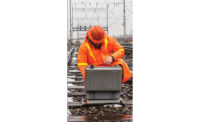As a yearend deadline draws near, U.S. railroads are making gains in putting federally mandated automatic train control systems in place, but a few carriers are in danger of failing to do all the work required by then and could face penalties.
The Federal Railroad Administration’s latest updates on installing positive train control (PTC) devices and systems, released on Nov. 21, show that as of Oct. 31, four of the 41 railroads subject to the program remained at risk of missing the deadline.
PTC, which includes wayside and in-locomotive equipment, aims to prevent train collisions, excessive speed or going through a mainline switch that isn’t in a proper position.
The National Transportation Safety Board, an independent federal body, has for years cited the lack of operating PTC systems as a major safety problem.
The rail lines still at risk are all commuter-rail carriers: the Capital Metropolitan Transportation Authority in Austin, Texas; Altamont Corridor Express in California; New Jersey Transit; and the San Francisco-San Jose area’s Caltrain, operated by the Peninsula Corridor Joint Powers Board.
FRA put railroads in the at-risk category if they had put in place less than 95% of PTC-required hardware on locomotives and at the wayside by the end of October.
In January, NJ Transit had only 12% of its PTC equipment installed and “the outlook was extremely bleak,” Executive Director Kevin Corbett told the agency’s board at its Nov. 14 meeting. But as of the day of that meeting, he added, “We are at 88% complete and will continue to work tirelessly to meet our yearend goals.” [View NJ Transit Facebook video of board meeting here.]
Still, Corbett acknowledged that “there is still a good deal of work to be done over the next two months and we are pressing ahead with all focus and energy that we need to make sure that we meet the FRA’s requirements…by the end of this year.”
The new FRA reports, released on Nov. 21, cover all 41 carriers as of Sept. 30 and the at-risk lines as of Oct. 31. Overall, they report notable progress this year on PTC, with the number of at-risk carriers down to four from 15 at the end of 2017.
Amtrak was rated at-risk as of Sept. 30 but made enough gains during October to leave that category.
As of Sept. 30, the control systems were operating on 71% of freight railroads’ PTC-covered route miles, but only 26% of passenger lines’ route miles.
Federal funding this year has helped the PTC program. Congress included $250 million in fiscal 2018 appropriations for implementing the systems and in August, FRA awarded $203.7 million of that to 28 projects in 15 states.
Carriers must meet the equipment requirement and five other mandates to qualify for an FRA-approved extension of the deadline for up to two additional year.
Railroads that fail to reach PTC compliance by Dec. 31 face a range of possible civil penalties.
An FRA spokesperson said via email that, for violations of federal rail safety laws, regulations or directive under the agency’s authority, the minimum statutory civil penalty it may assess is $870 and the ordinary statutory maximum penalty is $28,474.
The penalty amounts reflect new adjustments for inflation, as specified in a Nov. 27 Federal Register notice.
The spokesperson added that FRA can assess a penalty for each day of noncompliance but also “may elect to take enforcement action on a one-time basis or each month, quarter, year or other interval of time during which the noncompliance continues.”
In 2008, Congress mandated the use of PTC systems and set a Dec. 31, 2015, implementation deadline.
But when that date approached, it was clear that railroads couldn’t comply by then. About two months before the deadline, new legislation was enacted stretching the implementation date to the end of 2018, and allowing a further two-year extension if carriers made enough progress in meeting several implementation goals.
Story updated on 11/27/2018 with new, inflation-adjusted FRA penalty amounts.


